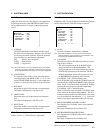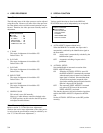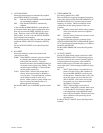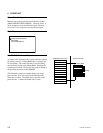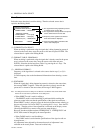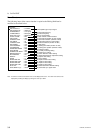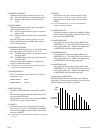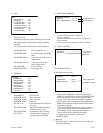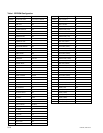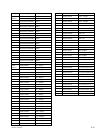
3-9
PFM-42B1, PFM-42B1E
INPUT SELECT : 0 0 0 0 0 0 0 0
YUV3
RGB1
RGB2
YUV1
DV
Y/C
LINE
YUV2
SYNC POL (H/V) : NEGA/NEGA
Horizontal sync polarity
Vertical sync polarity
(1) INPUT SELECT
The input signals that are acceptable to the
PFM-42B1/
B1E
are set.
This item consists of 8 bits. Each bit corresponds to
each type of input signal. Only the input channel to
which “1” is set, can be received by the
PFM-42B
.
Note : Regarding the LINE and Y/C input channels, these signals having
horizontal frequency of 15 kHz can be inputted. Because these input
signals pass through the double-speed processing circuit in the PFM-
42B circuit configuration, do not use the LINE and Y/C input
channels.
(2) INPUT SELECT 2
(3) H FREQUENCY
The horizontal frequency is set.
Note: This menu item cannot be modified in the DIRECT mode because the
DIRECT mode can edit the signal that is being inputted at present.
(4) V FREQUENCY
The vertical frequency is set.
Note : This menu item cannot be modified in the DIRECT mode because
the DIRECT mode can edit the signal that is being inputted at
present.
(5) SYNC POL (H/V)
Polarity of sync signal is set.
To set the polarity, select as follows:
Negative polarity : NEGA
Positive polarity : POSI
SOG : ___
Note : This menu item cannot be modified in the DIRECT mode because
the DIRECT mode can edit the signal that is being inputted at
present.
(6) TOTAL H PIXEL
The total number of dots in a horizontal period is set.
The number of dots that is set here becomes the initial
value of the user menu “TOTAL H PIXEL”.
Note : Set the total number of dots to satisfy the following conditions.
TOTAL H PIXEL > [LEFT EDGE + H RESOLUTION]
(7) LEFT EDGE
The horizontal sync width (in dots) + horizontal back
porch width (in dots) are set.
(8) H RESOLUTION
Horizontal resolution power is set.
Note : When 1280 or more is set to the horizontal resolution, picture may
not be displayed normally on screen. When a signal that has the
higher resolution than the SXGA signal, is going to be preset, reduce
the number of horizontal resolution by skipping or any other means
down to 1280 or less.
(9) TOP EDGE
The vertical sync width (in lines) + vertical back porch
width (in lines) are set.
Note : Set the TOP EDGE value to satisfy the following conditions.
[TOP EDGE + V RESOLUTION] < [horizontal frequency + vertical
frequency]
(10)V RESOLUTION
The vertical resolution is set.
Note : Set the V RESOLUTION value to satisfy the following conditions.
[TOP EDGE + V RESOLUTION] < [horizontal frequency + vertical
frequency]
(11)DOT PHASE
Pulse phase of the horizontal sampling frequency is
set.
The pulse phase that is set here becomes the initial
value of DOT PHASE of the user menu.
The pulse phase can be set in the range of 000 to 255.
(12)CP PLACEMENT
Clamp pulse position is set.
The clamp pulse position is set starting from the
trailing edge of horizontal sync signal (when data is
000). Increasing this value moves the clamp pulse in
the direction toward the picture area.
The clamp pulse generating position “Tcp” is given by
the following equation starting from the trailing edge
of horizontal sync signal.
Tcp = CP PLACEMENT / [horizontal sync frequency
x TOTAL H PIXEL] (in seconds)
(13)CP DURATION
Clamp pulse width is set.
The clamp pulse width is set starting from the position
that is determined by CP PLACEMENT. Increasing
this value widens the clamp pulse width in the direc-
tion toward the picture area.
The clamp pulse width “Wcp” is given by the follow-
ing.
Wcp = CP DURATION / [horizontal sync frequency x
TOTAL H PIXEL] (in seconds)
INPUT SELECT2 : 0 0 0 0 0 0 0 0
RGB3
D4
PC





